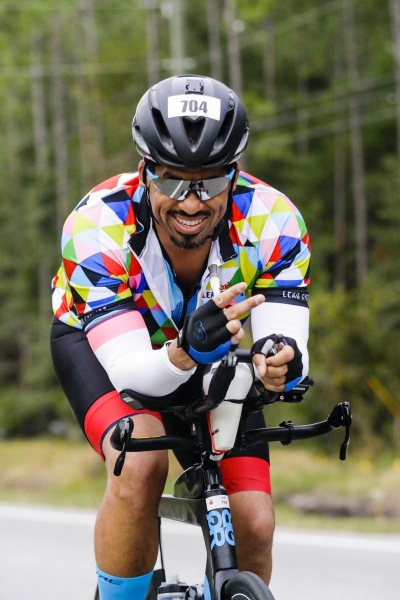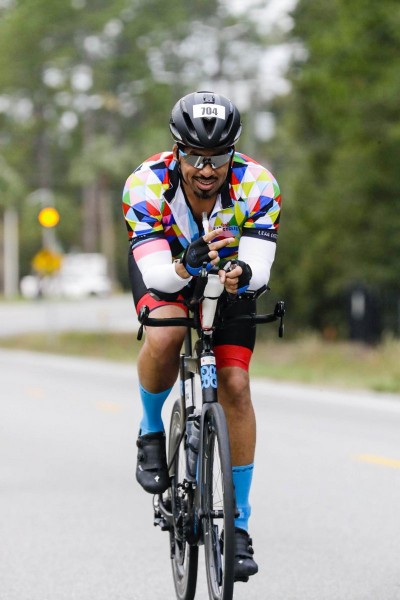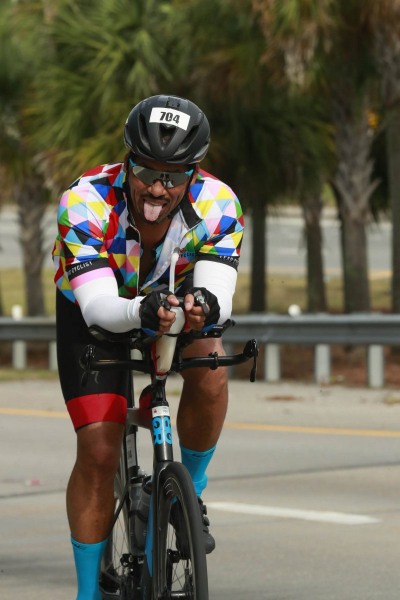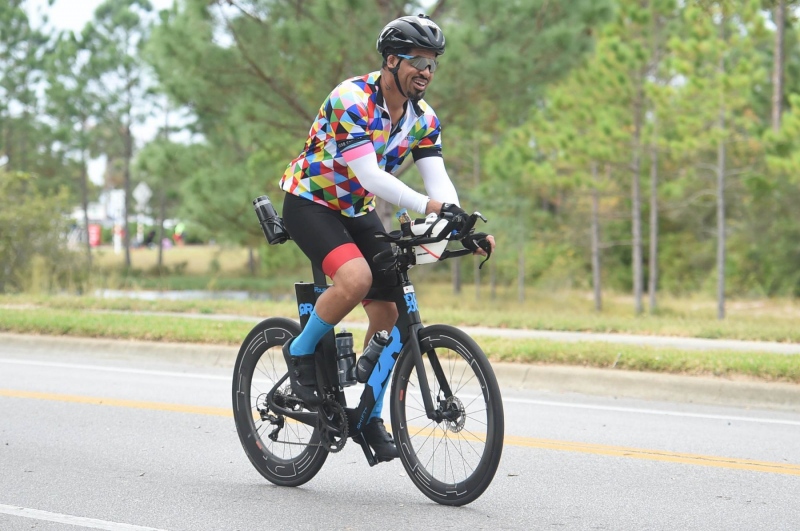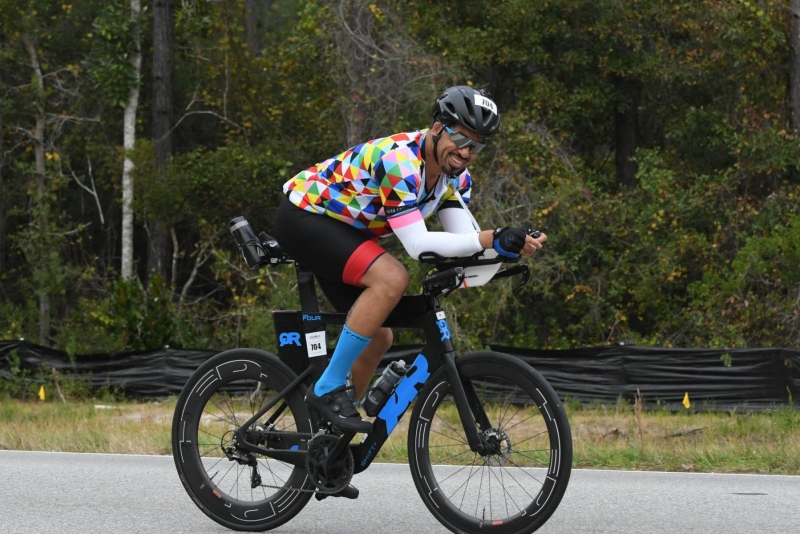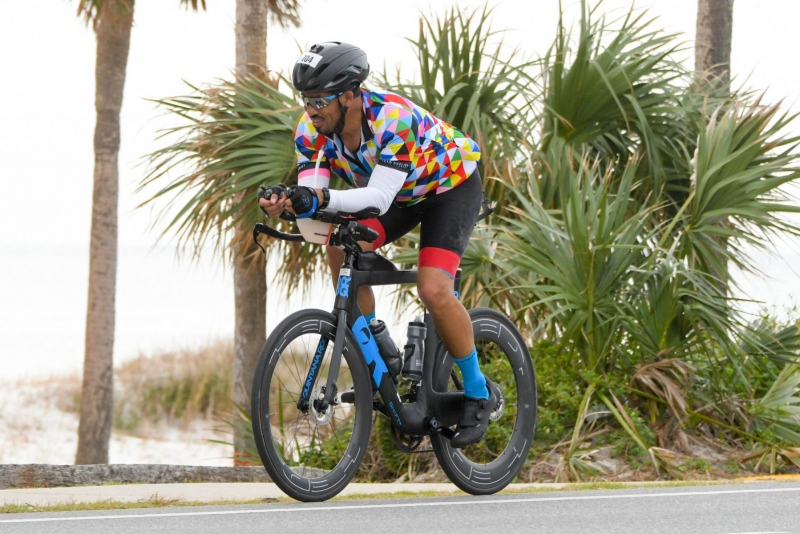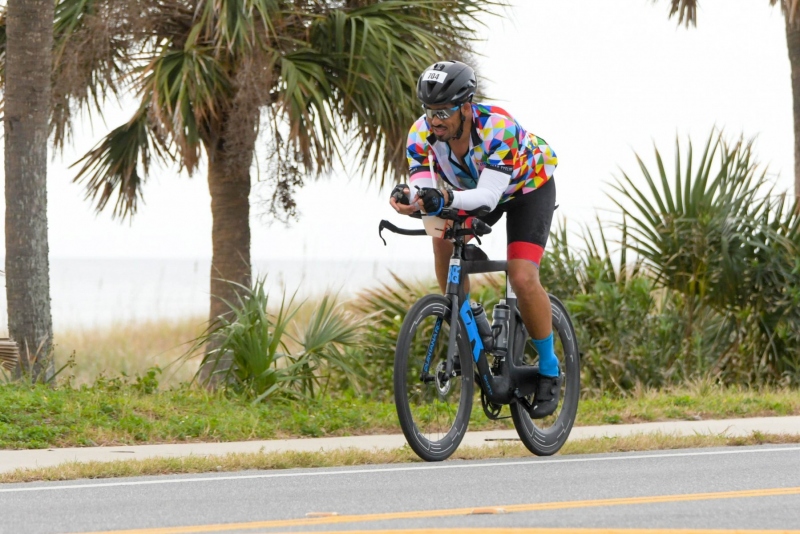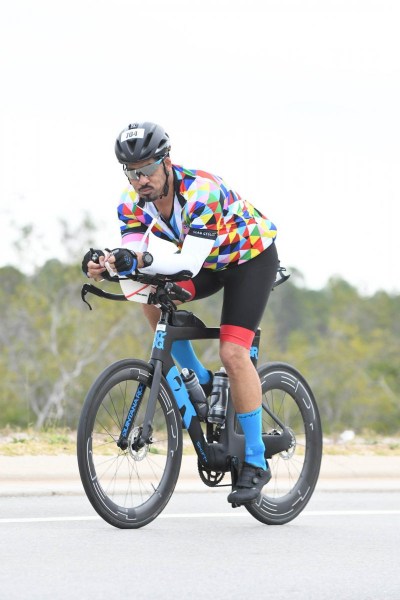I felt very good coming out of the water, I remember thinking that I would happily do another lap if needed. However, running on the sand, was a bear. As I was crossing the beach I kept thinking that this shit is taking way too much energy, get me on solid ground. From the beach, we ran through a chute, rinsed off by some overhead showers, and then across the street back to the transition area. Although this was a “spectator-free” event, people were lined up along the chute and cheering loudly for us. I enjoyed hearing the cheers and feeling the enthusiasm.
Once in transition, I tried to quickly get out of my wetsuit, and dry off. Putting cycling socks on wet feet is harder than you’d expect. The socks are thin and pretty tight. I guess that is why many people cycle without them. Another unconventional thing that I did was to put my cycling shorts and jersey over my tri suit. I knew that donning another set of clothes would take extra time, but the added comfort for the 6-hour ride was absolutely worth the delay.
In addition to wearing a cycling kit over my tri-kit, I brought lots of shammy butter. I brought enough packets to reapply it every 15-20 miles. During long training rides, I’d practiced applying it while riding knowing that I would need more during the race. I also brought sufficient Infinit Nutrition (in small Ziploc bags) for 1 bottle every hour. Again, this is the nutritional approach that I developed during the long weekend training rides. I discovered that my excessive sweat rate causes me to “burn” through the shammy cream every 20ish miles and deplete my electrolytes causing me to feel dehydrated unless I consumed about one bottle each hour.
Having practiced my nutrition so much leading into the race, I didn’t have any concerns about running out of energy or getting dehydrated. I wasn’t sure, however, if the butt butter would work with a tri-suit under the bike shorts. Fortunately, that was about the only thing I had to worry about and it was minor since I brought so much of it…I had sufficient quantities to apply it every 45 minutes If necessary.
Bike Objectives
I kept my objectives simple and easily achievable:
- Maintain my power as close to 150 Watts as possible. Even when I felt strong and excited, stay in my zone. I knew, from testing and practice, that I could maintain 150 W for 7 hrs and still have strong legs for the run. I wouldn’t be pushing my physical limits but should give myself ample time to run the marathon feeling relatively strong.
- Consume a full bottle of nutrition every hour and finish my peanut butter sandwich before reaching the half-way point. Repeat for the second half of the bike course.
- Stay in the aero position as much as I could and minimize stops.
With a clear head, a simple nutrition plan, and achievable goals, I had a great time during the cycling leg of the race. Being restricted from listening to music made me wonder how I’d cope with the silence for 6-7 hrs, but I ended up enjoying the sounds all around me. I also had the pleasure of riding next to some very interesting people, many of whom were happy to chat. According to the race rules, we were supposed to keep at least 12 meters (6 bike lengths) between each rider, but maintaining that distance was difficult to do with such a large difference in skills and comfort levels among the riders. Also, we often were riding along the shoulders of active state highways, so if we rode close behind someone who was going slower, immediately passing them was not always the safest option. We just had to pay attention to when the referees were nearby taking notes and giving out penalty time cards.
The first 30 miles of the ride were more frustrating than I would have liked due to a strong, incessant headwind. Since my goal was to stay within a narrow power range, my speed slowed considerably, averaging 14-15 MPH. During this section, I was passed by many of my Pearland Triathlon Racing Club teammates who were much slower in the water. Rather than jam the pedals, and allow my junkyard dog to wake up and cause me to chase them down, I stuck to my plan. I was racing myself, testing myself with individual goals that I wanted to achieve…the mental battles are just as real as the physical demands of the race.
The route was full of undulating hills and smooth asphalt which kept the ride interesting and pleasant. Triathlon bikes are very stiff, so when we ride on uneven or patched roads we feel all of the vibrations. Our wrists, shoulders, and butts become shock absorbers. So, although we were often riding with traffic, I was grateful that the race directors chose smooth and clean roads for us.
Aid stations were supposed to be every 15 miles but weren’t set up as frequently as that. I think there were two (possibly 3) aid stations for each half of the course. I didn’t mind because I had everything that I needed. When I did stop to use the bathroom, I collected some cups of ice to add to my water bottles. I also poured cold water on my head to cool my core a little.
Not surprisingly, around mile 85 I began wanting the cycling to end. My butt was beginning to hurt. I distinctly remember hitting mile 110 and seeing the banners for the transition area. I wanted nothing more than to be on my feet again and get off the damn bike. As much as I dislike running, I looked forward to starting the marathon. My ass was hurting. Real talk- I need to find a better seat during the offseason.
Overall, I think that I executed the bike leg very well. No energy dips, crashes, or violations. I stayed mentally present and aware during the entire ride and I discovered that I can push more power without sacrificing my ability to run afterward. Continuing to build my aerobic base will be my focus next year. Unfortunately, I was only able to sit in the aero position for about 60-70% of the ride which is not quite long enough. The discomfort of aero, I think, is due to having an improperly fitting seat, and having inadequately trained neck and shoulder muscles. All of these are fixable with time and practice.
Next up… I run the marathon to the finish line!

